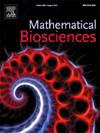Infection propagation in a tissue with resident macrophages
IF 1.8
4区 数学
Q2 BIOLOGY
引用次数: 0
Abstract
The progression of viral infection within the human body is governed by a complex interplay between the pathogen and the immune response. The initial phase of the innate immune response is driven by inflammatory cytokines and interferons produced by infected target cells and tissue-resident macrophages. These inflammatory cytokines not only amplify the immune response but also initiate programmed cell death, which helps slow the spread of the infection. The propagation of the infection within tissues can be modeled as a reaction–diffusion wave, where the speed of this wave is linked to the virus virulence, and the overall viral load determines its infectivity. In this study, we demonstrate that inflammation reduces both the speed and viral load of the infection wave, and we establish the conditions necessary to halt the spread of the infection. Depending on the relative strength of the infection and the immune response, there are three possible outcomes of infection progression. If the virus replication number is sufficiently low, the infection does not develop. For intermediate values of this parameter, the infection spreads within the affected tissue at a decreasing speed and amplitude before ultimately being eliminated. However, if the virus replication number is high, the infection propagates as a reaction–diffusion wave with a constant speed and amplitude. These findings are derived using analytical methods and are corroborated by numerical simulations. Additionally, we explore viral diffusion, comparing the conventional parabolic diffusion model with the hyperbolic diffusion model, which is introduced to address the limitation of infinite propagation speed. Our results show that while the viral load remains the same across both models, the wave speed in the hyperbolic model is smaller and approaches that of the parabolic model as the relaxation time decreases.
感染在巨噬细胞驻留的组织中传播
病毒感染在人体内的进展是由病原体和免疫反应之间复杂的相互作用所控制的。先天免疫应答的初始阶段是由被感染的靶细胞和组织内巨噬细胞产生的炎性细胞因子和干扰素驱动的。这些炎症细胞因子不仅放大了免疫反应,还启动了程序性细胞死亡,这有助于减缓感染的传播。感染在组织内的传播可以建模为反应扩散波,其中该波的速度与病毒的毒力有关,而总体病毒载量决定了其传染性。在这项研究中,我们证明炎症降低了感染波的速度和病毒载量,我们建立了停止感染传播所需的条件。根据感染的相对强度和免疫反应,感染进展有三种可能的结果。如果病毒复制数足够低,则不会发生感染。对于该参数的中间值,感染在受影响的组织内以递减的速度和幅度传播,最终被消除。然而,如果病毒复制数高,则感染以恒定速度和振幅的反应扩散波传播。这些发现是用分析方法得出的,并得到数值模拟的证实。此外,我们探讨了病毒的扩散,比较了传统的抛物线扩散模型和双曲扩散模型,这是为了解决无限传播速度的限制而引入的。我们的研究结果表明,虽然病毒载量在两种模型中保持相同,但随着松弛时间的减少,双曲模型中的波速更小,并接近抛物线模型的波速。
本文章由计算机程序翻译,如有差异,请以英文原文为准。
求助全文
约1分钟内获得全文
求助全文
来源期刊

Mathematical Biosciences
生物-生物学
CiteScore
7.50
自引率
2.30%
发文量
67
审稿时长
18 days
期刊介绍:
Mathematical Biosciences publishes work providing new concepts or new understanding of biological systems using mathematical models, or methodological articles likely to find application to multiple biological systems. Papers are expected to present a major research finding of broad significance for the biological sciences, or mathematical biology. Mathematical Biosciences welcomes original research articles, letters, reviews and perspectives.
 求助内容:
求助内容: 应助结果提醒方式:
应助结果提醒方式:


